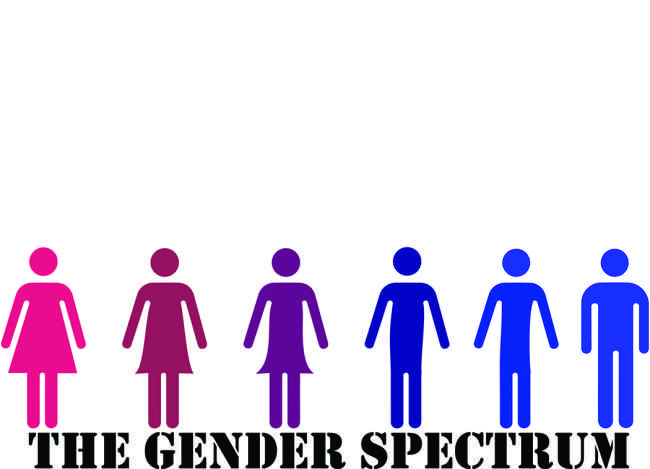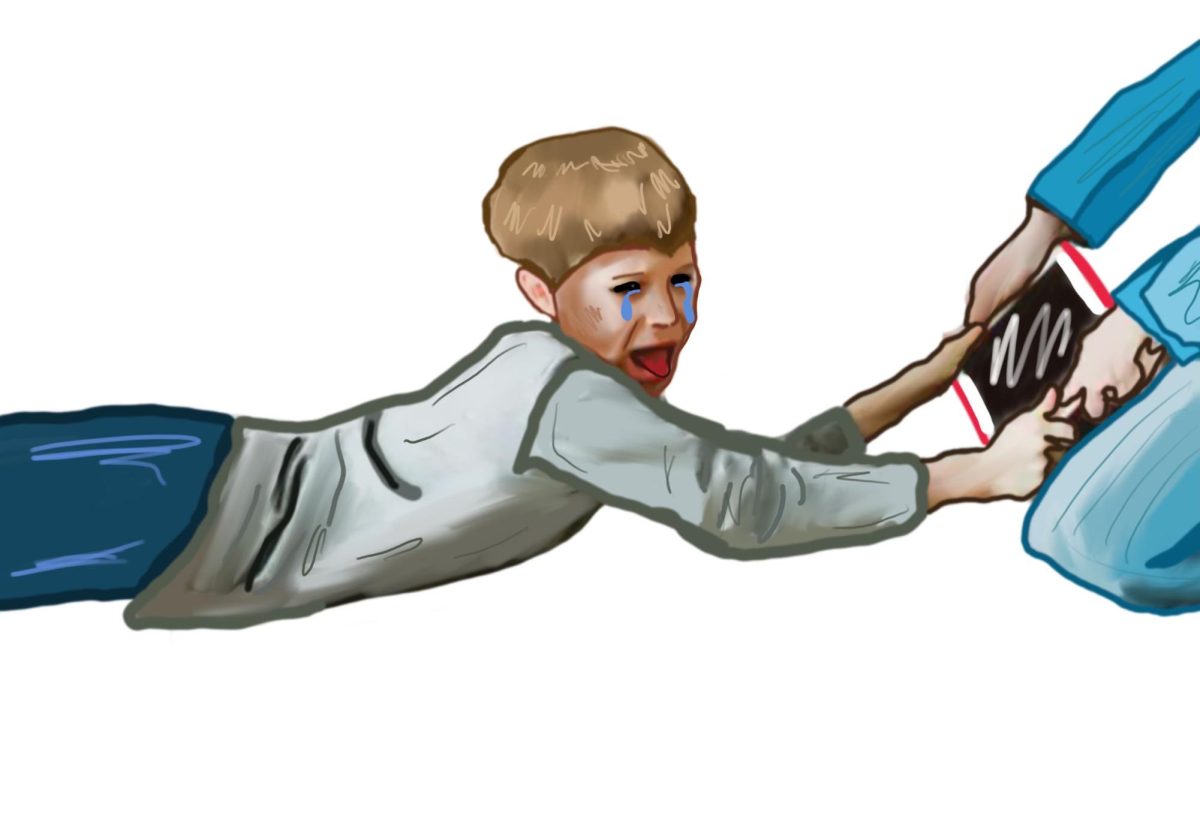By Robin Naylor
Going to Toys ‘R Us as a 7-year-old was like winning a free ticket to the VIP section of Outside Lands. You walk in, smell the cheap plastic, and run toward the Hot Wheels Cars.
But the store clerk is in your way. He points to the sign of the toy car aisle, and gives you that same look that campus security gives you when you walk in late to first period. The aisle is astoundingly blue, from shelves, to tiles, to packaging. Your mom is dragging you to the pink-haired Polly Pockets, and for the first time you understand what sets boys and girls apart.
When it begins, it’s just the colors on the blankets you receive at the hospital when you’re born. Then it’s the toys you play with in kindergarten. Then you’re in AP Literature while your guy friend is in AP Economics, and he’s the one to ask you to prom with an explosion of pink glitter and roses.
But what if you feel wrong in this mold?
As a recent Bark survey revealed, for 7 percent of Redwood students, the question of gender isn’t as simple as the blue or pink blanket assigned to them at birth. They are facing questions of identity that go beyond the status quo: They identify as transgender.
A person’s sex is the biological and physiological characteristics that make them male or female, while gender is the behavior, attitudes and feelings that society aligns with either biological sex, according to The American Psychological Association.
“I came out as trans the beginning of junior year, ” said senior Frenchy Mascaro, who generally prefers the pronouns “they” and “them” instead of gender specific pronouns. “There are different varieties of [transgender] like female to male, male to female, all that stuff, and I figured out that I was more genderfluid.”
Genderfluid and genderqueer are two of the many terms used to describe people whose gender lies outside of the binary. “Binary” is the term that describes the two fixed gender categories of girl or boy. Transgender, an umbrella term, refers to people who transition from girl to boy and vice versa as well as those who identify outside the gender binary.
Sophomore Talia Klein is non-binary, and also prefers the pronouns “they” and “them.” Some days, Klein identifies as a girl, and some days they do not.
Klein said that the transgender community was the first place where they could feel comfortable in their own skin.
“When I was younger I never really felt like I fit in as a girl. It’s what everyone else was doing and I was born female,” Klein said. “But I was never quite comfortable as [a girl]. When I grew up I realized there was this whole other community of trans people. ”
Mascaro and Klein said they have generally been accepted at Redwood for their gender identities. Others, however, face adversity.
“Evan,” a senior at Tamiscal who wished to remain anonymous, transferred from Redwood before his junior year because he felt judged for being a transgender boy.
“We’re standing on our number in P.E, and we had a sub that day, and the sub looked at me, looked at the name on the list, looked at me again,” Evan said. “He looks at me, looks down and kind of does this double take. And he’s like, ‘Are you…’ and then he says my birth name. And I’m like, ‘Yes…’ and he goes, ‘Oh I thought you were a boy.’”
At Redwood, this case of mistaken identity was not uncommon for Evan, who, at the time of the interaction, went by a gender neutral nickname and appeared androgynous, as he was not yet “out” as transgender.
“I guess the social pressure kind of got to me, eventually. So when people would ask me, ‘Are you a boy?’ I’d be like, ‘What, are you kidding?’ I’d act really upset over it, but I didn’t actually feel that upset over it,” Evan said. “What began to upset me was when people said things like ‘Young lady.’”
According to a recent Bark survey, 20 percent of Redwood students don’t consider a transgender woman a “real” woman.
Coming out

Teens who fall under the transgender umbrella often face a difficult transition period of coming out to their friends and family.
Popular media’s portrayal of the process does not help, Klein said. Many movies and TV shows depict the transition period for trans youth as rough, so this perceived experience is one trans youth in real life come to expect for themselves.
“I think that portraying a trans person, like say Caitlyn Jenner, is not representing the trans community as it really needs to be represented because, in her case, her transition was made easier by resources that she had,” Klein said. “Trans people don’t really have that many representatives in the media that are accurate to people’s everyday struggles and the things that people deal with everyday.”
The widely viewed T.V show Orange is the New Black, for example, shows the coming out process of a trans woman as one rocked by turmoil and dejection, setting a distressing expectation for teens coming out today.
“I thought I was gonna get kicked out. I have a lot of friends who are trans––they’re trans-boys, trans-girls, they’re all these different binary stuff––and the first thing they tell me is, ‘My parent’s didn’t get it at first,’” Mascaro said.
Trans teens face the unique challenge of telling their loved ones that an integral part of their identity does not match the world’s perception of them.
“Freshman year, I told my mom, ‘All these changes that were happening to my body through puberty were making me really uncomfortable,’” Evan said. “And she said, ‘All girls feel that way, you’ll be fine.’ I never brought it up for years after that.”
For those who are genderqueer, coming out to loved ones can double as a lesson about the gender spectrum.
“Some days I do feel like a girl, like the girl I was born into, but some days I don’t––I feel like nothing, like I don’t have either. Some days I feel like a boy, sometime I feel like both, it’s really fluid,” Mascaro said.
Mascaro came out to their dad before coming out to their mom because they felt that their mom’s strict Catholic upbringing would prevent her from accepting them.
Mascaro’s father’s reaction was better than they expected.
“My dad’s like, ‘Really that’s all? Like you’re worried about telling me that, that’s YOU?’” Mascaro said. “I freaked out for nothing because he told me that ‘I’ll always love you no matter what, as long as you’re happy.’ Not gonna lie, I cried like a baby.”
Klein has yet to tell their parents about their identity.
“I’ve come out to most of my friends. I have not come out to my family yet, but they’ll find out at some point. I’m just nervous it’ll change their opinion of me,” Klein said.
In School
Although the Bay Area has historically been known as a safe haven for people of varying sexual and gender identities, young adults figuring out their identities say they are subject to conflicting messages in school.
“We weren’t really taught about it until eighth grade, and it was a one-day lesson, and nobody took it seriously. It was extremely vague,” Klein said. “They gave us this little diagram. It was a person, and it said “The Genderbread Person” and they tried to tell us about the gender spectrum, but it didn’t make sense to a lot of people––it didn’t make sense to me then either.”
Social Issues, the social studies class taught to all freshmen, covers sex education, but some don’t see it that way.
“Social Issues was probably the worst. They spent less than five minutes talking about trans people,” Evan said. “I don’t want kids to have to do a report on it or anything because sometimes when you bring attention to things like that in class, students treat it really negatively, and it gives them more reason to joke about it sometimes.”
As the sole teacher teaching Social Issues this semester, Stephen Hart said he makes sure to include gender issues in his curriculum. Hart wasn’t yet teaching at Redwood when Evan was a freshman.
“I wouldn’t say that even I cover it at length. However, I do devote usually about a week to talking about issues regarding gender and sexual orientation. I don’t think we’ve ever talked in depth about the experience of being transgender. It’s more so about acknowledging that there are other ways to identify outside the gender binary.”
Klein also thought that the Social Issues lesson on transgender issues was too terse.
“It was vague. A lot of my classmates didn’t understand it and [the teacher] didn’t check for comprehension of it. It was just pushed away after that day, which I think was kind of odd,” Klein said. “There could have been kids in that room struggling their own gender identity. Maybe they needed that information.”
As transgender issues become more publicized and transgender people gain the courage to come out, resources for transgender youth are increasingly easy to find.
“It’s really nice to have people come in and speak, so maybe a genderqueer person could have come in and talked about it, or someone who even has a family member or relative who’s genderqueer. That would have really opened people’s eyes, and make them see like, ‘Oh this is a person who’s dealt with that,’” Klein said. “Right now it’s just not really out there in the curriculum, and if you want to really know about something you have to go out and learn it yourself. Not all people necessarily have the motivation to do that.”
The Gay Transgender Straight Alliance club (GTSA) is another source to which students can turn with questions. Evan, however, didn’t feel comfortable joining the club because he said there was a social stigma.
“The GTSA of a school has the power to basically make or break some of these students lives,” Evan said. “Nobody would talk about [the club] and I was afraid of the stigma of what would happen if I did go there because then everyone would know that I was a ‘lesbian.’ I showed up once. And then I left, because they talked about how they felt and that’s it.”
The president of the GTSA, senior Matthew Moser, thinks that the club is best utilized as a “safe space.”
“While we may talk about our feelings, it’s not about what us, as the [club officers] want. It’s about what the people in the club want because we are here to help them,” he said. “ There is no social stigma coming to this club. We’re open to anyone regardless of gender or sexuality, anyone questioning, or who just wants someone to talk to––that’s what we’re here for.”
Bathrooms and locker rooms

In 2013, the GTSA spearheaded an initiative to add transgender inclusive signs to the bathrooms. The signs were in response to Gov. Jerry Brown’s trailblazing passage of AB1266 on August 13, 2013, which lets students choose the bathroom, locker room, and sports team of the gender with which they best identify.
Evan said that while the sign on the girls’ bathroom was generally well received, the boys’ sign got little respect.
“The one on the boys’ bathroom always gets ripped off. It did pretty much nothing but create more work for the people who had to tape it back on all over again,” he said.
According to a recent Bark survey, 87 percent of Redwood students believe that transgender students should be able to use the bathroom and locker room of the gender with which they identify.
A new unisex bathroom next to room 306 created a lot of buzz in the trans community at Redwood when it opened with an “All Genders Welcomed” sign that was later changed to “Unisex.”
“I still have no idea why they took it off but I really want to know. It’s just little things like that that make me feel unwelcome,” Evan said.
Mascaro thought differently about the bathroom, noting that the gender neutral sign got flack from the greater student body.
“I think it would be a lot better with the unisex bathrooms because when a gender neutral bathroom sign was installed over there by room 306, a lot of people were making fun of the sign. Maybe a unisex bathroom would be a little easier for people to digest than a gender neutral one,” Mascaro said.
In the locker room, transgender and genderqueer students are still struggling to find a foothold despite the legislative breakthrough––just because something is law, does not mean that it is enforced, Evan said.
“Freshman year, there were times where people who thought that I wasn’t in the locker room talked about me, saying, ‘I don’t want to have to share a personal space like this with a lesbian. It’s like having a guy walk into the locker room and stare at me.’ But I was dating a guy at the time,” Evan said.
For genderqueer Klein and Mascaro, the locker room is a place where they may or may not be comfortable in at any given time, depending on how they identify that day, they said.
Bullying banner
It is not a new phenomenon for students with different identities to face negative reactions from peers. Though many may believe that bullying doesn’t occur at Redwood, 29 percent of the total student body reported being bullied at school in a recent Bark survey.
“I would get really paranoid about people whispering about me because it would happen all the time, like everyday in all my classes,” Evan said.
According to a study done by the National Center of Transgender Inequality in 2011, 82 percent of transgender youth feel unsafe at school.
“P.E was a time where it was particularly bad. I was walking out of the locker room, and there were these two people, a guy and a girl, who referred to me as ‘it,’” Evan said. “I’m a freshman, I’m 14. I’m just like, ‘That’s never happened before, oh my god.’”
The “coming out” process can be emotionally draining for teens whose peers do not understand what it means to be transgender. Klein said they have had people “give a type of look” that conveyed they didn’t understand and “didn’t try to understand” Klein’s identity when Klein told people about their pronouns.
“It made me feel kind of unwelcomed and uncomfortable. It was not a good feeling overall when you find that this is who you are, it’s your identity, and you’re sharing it with other people and they just reject you for it,” Klein said.
Some in the trans community stress the importance of asking for someone’s pronouns upon meeting them.
“I think a good thing to do is just when you meet someone, ask what their pronouns are. That’s something really respectful, and it’s nice if you’re going to be referring to someone to use the correct pronoun,” Klein said.
Switching from one pronoun to another is an integral part of being transgender, and when friends and family acknowledge the switch, it can be a subtle way for them to show they accept someone’s transition, according to Klein.
“Both sides of my family are from Peru, ” Mascaro said. “They were like, ‘We can’t really say your pronouns in Spanish, but we’ll respect your wishes.’ Spanish is hard with ‘they.’ They just kind of say ‘she,’ and I’m like, ‘That’s fine, I get it. It’s hard for you guys, but you’re trying and I can see that.’”
Mascaro came out to their teachers last year, and says that their teachers were all very accommodating of their new pronouns.
Not everyone is so understanding, as Evan remembers.
“The spring of freshman year, I think it was the day where the taunting was really bad, I tried to explain to someone who I knew, what ‘they’ pronouns were,” Evan said. “They said, “‘What, are you two people? That’s a plural pronoun, that doesn’t make any sense to me. That’s weird.’ They basically completely invalided an essential part of my identity, and I was horrified.”
Gender Norms
During his sophomore year at Redwood, Evan decided to dress more traditionally feminine in an attempt to fit in and alleviate bullying about his gender.
“While other people were highly responsive to this, everybody was like, “Wow you look so cute!” Evan said. “I would get all of this positive attention from the people who I liked, like my boyfriend, my parents, teachers even. But I never felt more alone.”
A big part of a trans person’s life is the way they choose to express, or repress, their preferred gender through clothing or behavior.
“Common misconceptions are that you have to act one gender, like you have to act completely female. This includes skirts and makeup and nail polish and all those things that apply to being female, but they’re not. And if someone is wearing a dress you should not assume that they are a girl, ” Klein said. “Same goes for generalized boy’s clothing––if someone dresses like a boy or they kind of appear like your stereotypical boy, that doesn’t necessarily mean that they’re a boy.”
During his attempt to conform to gender norms, Evan said he felt a greater sense of gender dysphoria than when he had dressed like a tomboy.
“I would look at myself, and I would see an, I guess, slightly attractive female in the mirror, but I never once associated it with myself. It felt like I was looking at somebody else. I had never felt such a level of disgust for myself,” Evan said.
Gender dysphoria is the distress one feels because there is a mismatch between their biological sex, or the one given to them in the delivery room, and their gender identity, according to the American Psychiatric Association.
“I have faced body dysmorphia as well, regarding my boobs, because I don’t really bind my boobs, I just wear a sports bra, ” Mascaro said.
“Binding” refers to the way that some trans men and genderfluid people use tight bandages to minimize the appearance of their breasts.
“It’s actually kind of bad cause they can really hurt your ribs, and it makes it hard to breath, and there have been cases of lung problems,” Mascaro said.
For trans boys, restricting their breasts and giving the impression of a flat chest lessens the uncomfortable feelings associated with body dysphoria and helps them “pass” as men, according to Evan.
“I was curious, so I tried it. It hurt, a lot. It was really bad. Note to kind of everybody I suppose: don’t try it ever. You will break your ribs. That didn’t happen to me, but it’s happened to some people I know,” Evan said. “I put a shirt on afterward and I kind of looked at myself and was just like, “Yeah, I can do this.” It was more kind of comforting almost.”
Depression
LGBT youth are six times more likely to have serious depression than non-LGBT kids, according to the Center for Disease Control.
“I took a lot of pills with the intent to kill myself when I was 14, when I was 15, and once when I was 16,” Evan said.
41 percent of transgender people attempt suicide at least one time in their lives, according to a study by the American Foundation for Suicide Prevention.
“Thankfully nothing bad happened. I just kind of threw up a lot. I never went to the hospital because the first few times, nobody knew about it,” Evan said. “I felt like it was worth it to not exist rather than be who I was supposed to be because I did not know anybody like me,”
An April 2011 study published by the Williams Institute found that 0.3 percent of the population identified as transgender.
“I knew they were out there, but I knew that they would get murdered or beat up upon being found out, or oversexualized in some groups, [or called] “tranny.” I was afraid that I would be the next target,” Evan said.
There was an 11 percent increase in homicides experienced by LGBT communities from 2013 to 2014, according to the National Coalition of Anti-Violence Programs.
“I had thought about suicide. And my dad was like, listen, ‘The bad stuff that’s happening now, don’t take it as a way to end it all, take it as a way to say [expletive] you to all the haters who say you can’t be trans or you can’t be a certain way, or you have to look a certain way. Tell them [expletive] you for surviving all this shit, because this is tough shit,’” Mascaro said. “And so I did. Here I am today!”
























